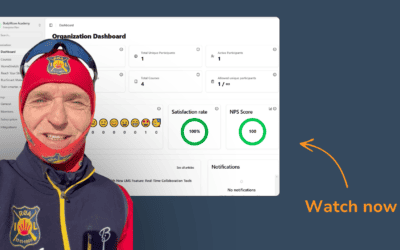How to convert classroom-based training to the online format
The extraordinary situation we now are in has led many training providers to test out the online training format for the first time. We know that to convert classroom-based training to online training can be a somewhat bumpy road. So we decided to give some guidance to all the training providers who are now about to do the transition, are already in the starting process or for those want to improve their classroom to online training conversion process.
As with the two first vodcasts in our vodcast series (How does the covid-19 pandemic affect the training market in the short and long term and Benefits of online training from the perspective of the training providers and the delegates), we teamed up with our favorite Professor Andersen to discuss some practical steps on how to convert classroom-based training to an online format. Click on the red play button on the video above too see the video interview, or read on if you prefer to get it all summed up in a text format.
Join our newsletter here to not miss more content like this.
Okay, let’s move on to the summary.
How to convert classroom-based training to an online training
This vodcast is a discussion between Dag Lyster, CEO of FrontCore, and Espen Andersen, Associate Professor of the Institute of entrepreneurship and strategy at the Norwegian Business School, BI. Espen is leading the Digitalization Research Center at BI, and is an authority within online teaching through his own work.
In this vodcast the two will discuss the the practical staps you need to take when converting classroom-based training intro an online training/ e-learning format. Below you will find a written summary of the discussion.
The three phases
Espen highlights three different phases you have to go through when you make a shift from classroom-based training to online training. Here is a summary of the three phases.
1. Just get online
In this first step, it is all about digitizing. Take what you already have and make in available online. Do not think too much about adjusting the formats and making it perfect. Just make it work.
For many training and course providers, this phase will mean making what they used to consider being their side activity to be their new main activity. These providers already have the technology they need, because they are already offering some training online.
For others, this phase means getting new technology such as camera, microphones, learning platforms etc.. They have to spend time on learning these tools while practicing it.
In both of these cases, the provider have to communicate and tell the students about what is going on and show that they care about the student (eeven though everything might not be working ideal – yet). In this first stage, your students are very forgiving. This means that you are able to just try your best and improve along the way. But remember: The students patience is not there forever.
2. Adjust to the new format
Once you have everything online and feel that you have your head over water, it is time to make some adjustments to you delivery format.
Why? Because what you do in physical classroom does not necessarily work online.
A typical physical classroom session is often something like this:
- The instructor is talking in front of the participants and usually use a PowerPoint presentation.
- After the presentation, there is a classroom discussion.
- Sometimes, in the end of the session: A test.
Instead of doing the exact same thing in the virtual classroom, you should do some adjustments. Here are some suggestions:
- Split the content and activities into smaller pieces, so that you are not forcing your participants to sit in front of a computer screen for too long. This is one of the benefits of online learning: It is easy to split the training into shorter and more specific sessions.
- The instructor can record the presentation with the Power Point. The students can now decide when and where they will watch the presentation, and the instructor can reuse the video recording later.
- Have live conferences with the instructor and the participants, so that the participants get the chance to ask questions, interact and discuss with each other.
- Think of the “flipped classroom” strategy: Introduce the participants to the learning material before class and use virtual classroom time to deepen understanding through discussion and problem-solving activities facilitated by the instructor.
And remember: What kind of adjustments you should do depends on what kind of training you deliver, who your students are, and what kind of online format you are using. This phase is all about making your training fit the online delivery format you have chosen.
11 steps to a web-based course
your participants won't forget
3. Reinvent your business model
When you have converted all or most of you training to the online format, you have to reinvent your business model to fit the new normal. Your costs, the way you do your marketing, how you set you prices, and how your whole organization works is now different.
For example: If your business are paying your instructors based on hours in the classroom, that does not really make sense in the digital world. Even though the instructor made a 30 minutes long video for a course, he probably spent several days making it. And once the video was made, he can use it over and over.
It can be hard to make these decisions in the situation the word are in right now. But the longer this goes on, you have to consider going into this third phase. Maybe the move to offering online training only is better in the end, regardless of the development of the corona outbreak. It is a hard decision to make, I know.
Common mistakes when converting training to online training
While converting your classroom-based training to online training and e-learning, there are some common mistakes you should try to avoid.
- To think that your current decision-, remuneration-, and administration models will work the same way with the online format. You have to do adjustments.
- To centralizing every decision in the conversion process. Let people make their own decisions, or at least take part of the decisions. This way, they will feel ownership of their new normal.
- People tend to worry about stuff like bad quality videos and so on. Stop worrying, spend your time on learning the new stuff, and approve along the way.
- To do things exactly the same way as in the physical classroom. For example, managing discussions in an online format is different from doing it in a classroom. It needs much more structure.
- To not set the right expectations for the students. The instructor cannot respond to emails 24/7, even though the students have access to the training material 24/7.
- To not make room for enough breaks during sessions. It is easy to forget about them breaks because you are not feeding back on your student’s energy in the same way as in the physical classroom.
The key success factors for converting from classroom training to online training
- Find the right format for your training type.
- Transition to shorter units of learning that can be reused in many settings.
- Consider he possibility to offer the small units by themselves and in combinations, so that you can offer a wider range of training
- Consider having subscription based offers
- Find the right tools
- Focus on engagement and learning the outcomes
Best tips for those who are doing this for the first time
Espen has made a video about five things you should consider when moving your training online. In our interview, he also mentioned the following tips for the instructors:
- Look into the camera
- Sound is more important than the picture
- Know your stuff and care about the people on the other side. If this is always in the back of your mind, you will succeed.
- Learn along the way
Don’t miss out!
I hope you enjoyed our third vodcast! Sign up for our newsletter, and we promise to let you know when we are posting more stuff like this. Sign up here.
Did you like this article? Don't forget to share it:
About FrontCore
Over 3700 training providers use solutions from FrontCore – and that’s not without reason. FrontCore is one of Norway’s leading competence environments within cloud based systems for Training Management, Learning Management and Webmarketing. With over 23 years of experience from the training industry and our finger on the market pulse continuously, we help course and training providers achieve more efficiency and higher revenue.
Products

Related articles
Guide: How to start a training business
Thinking of starting your own training company in the UK? Get all the essential steps, insights, and expert tips in this complete guide—plus how the right tools can help you succeed from day one. Ready to launch your training business?
Kirkpatrick model: How to use it in your training business
Curious about how to measure your training’s true impact? Discover how the Kirkpatrick Model can help you improve your courses, boost participant satisfaction, and achieve real business results.
A new version of our LMS is here: More flexible, engaging, and smarter than ever
Upgrade your LMS experience with a smarter, more flexible platform. Discover a new course editor, AI-powered tools, embedded quizzes, and smarter dashboards that enhance learning and engagement. Ready to transform your e-learning?








0 Comments